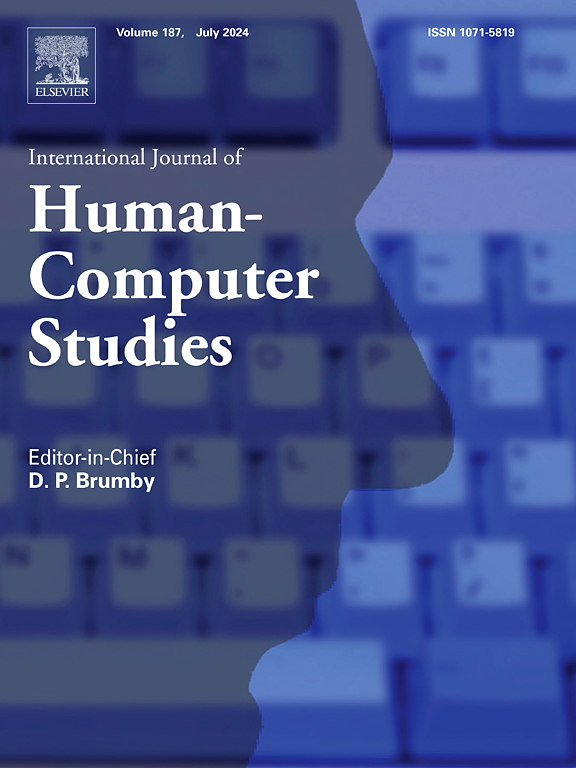研究体积分割对混合现实中动作训练的作用
IF 5.3
2区 计算机科学
Q1 COMPUTER SCIENCE, CYBERNETICS
International Journal of Human-Computer Studies
Pub Date : 2025-03-31
DOI:10.1016/j.ijhcs.2025.103499
引用次数: 0
摘要
分割是一种分割数据集以帮助理解的技术。对于人体的静态可视化而言,数据分割通常侧重于揭示内部层次,如器官或肌肉。不过,对于人体运动的动态可视化而言,分割还涉及将复杂的人体运动时间序列解构为更小的排列组合的过程。这一过程与学习新动作尤其相关。这类动作训练通常需要指导者和学习者在同一地点进行表演、模仿和分析演示的肢体动作。混合现实技术已被提出来帮助动作学习,为参与者提供实时和视觉反馈。然而,现有的方法通常使用抽象的或虚拟化身的表现形式,并将重点放在整个肢体动作上,而不是与特定练习相关的特定肢体动作上。在本文中,我们提出了一种分割技术,用于从语义上分离肢体动作的体积记录,从而支持在动作训练中学习新技能。该技术可捕捉整个运动过程中照片般逼真的个人特征,并对单个身体片段进行空间和语义分割。将分段技术应用于动态动作,可使学习者在技能训练中关注特定身体部位的运动轨迹。我们进行了一项构思研究,通过视频会议工具,使用远程可用性虚拟现实方法(称为 "Surrogate-Aloud"),调查体积记录和分段技术在动作训练领域的应用。参与者利用体积分割法构思了一些场景,并认为分割法是一种有价值的工具,可以更好地理解复杂的动作,并更好地识别单个肢体的运动轨迹。在物理治疗、假肢教育和运动训练小组课程等其他多个使用领域,人体体积分割的价值也得到了认可。本文章由计算机程序翻译,如有差异,请以英文原文为准。
Examining the role of volumetric segmentation on movement training in mixed reality
Segmentation is a technique to partition datasets to aid in comprehension. For static visualizations of the human body, segmentation of data is typically focused on exposing internal layers, such as organs or muscle. However, for dynamic visualizations of body movements, segmentation can also involve the process of deconstructing complex temporal sequences of body movement into smaller arrangements. This process is particularly relevant to learning new movement. Such movement training exercises commonly involve a co-located instructor and learner in the same place, performing, imitating, and analyzing demonstrated body movements. Mixed Reality technologies have been proposed to aid in movement learning, affording participants real-time and visual feedback. However existing approaches commonly use abstract or avatar representations, and focus on the entire body movement, rather on a specific bodily movement relevant to a particular exercise.
In this paper, we propose a segmentation technique to semantically isolate volumetric recordings of body limb movements, thereby supporting the learning of new skills in movement training. The technique captures photo-realistic personal characteristics throughout a movement, applying spatial and semantic segmentation to individual body segments. Applying the segmentation technique to dynamic movements enables learners to focus on the trajectory of specific body parts during skills training. An ideation study was conducted to investigate the use of volumetric recordings and segmentation in the domain of movement training using a remote usability virtual reality method via video conference tool, called Surrogate-Aloud. Participants ideated scenarios using volumetric segmentation and considered segmentation to be a valuable tool to better understanding complex movements and to better identify individual body limb trajectories. The value of volumetric segmentation of the human body was recognized in a variety of additional usage domains, including physiotherapy, prostheses education, and group classes for movement training.
求助全文
通过发布文献求助,成功后即可免费获取论文全文。
去求助
来源期刊

International Journal of Human-Computer Studies
工程技术-计算机:控制论
CiteScore
11.50
自引率
5.60%
发文量
108
审稿时长
3 months
期刊介绍:
The International Journal of Human-Computer Studies publishes original research over the whole spectrum of work relevant to the theory and practice of innovative interactive systems. The journal is inherently interdisciplinary, covering research in computing, artificial intelligence, psychology, linguistics, communication, design, engineering, and social organization, which is relevant to the design, analysis, evaluation and application of innovative interactive systems. Papers at the boundaries of these disciplines are especially welcome, as it is our view that interdisciplinary approaches are needed for producing theoretical insights in this complex area and for effective deployment of innovative technologies in concrete user communities.
Research areas relevant to the journal include, but are not limited to:
• Innovative interaction techniques
• Multimodal interaction
• Speech interaction
• Graphic interaction
• Natural language interaction
• Interaction in mobile and embedded systems
• Interface design and evaluation methodologies
• Design and evaluation of innovative interactive systems
• User interface prototyping and management systems
• Ubiquitous computing
• Wearable computers
• Pervasive computing
• Affective computing
• Empirical studies of user behaviour
• Empirical studies of programming and software engineering
• Computer supported cooperative work
• Computer mediated communication
• Virtual reality
• Mixed and augmented Reality
• Intelligent user interfaces
• Presence
...
 求助内容:
求助内容: 应助结果提醒方式:
应助结果提醒方式:


